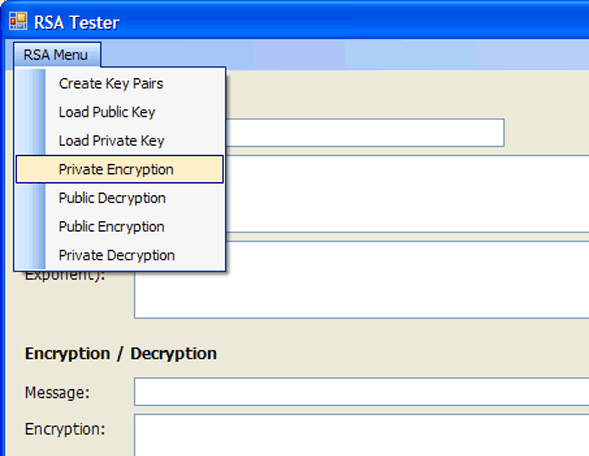RSA Introduction
The RSA (Rivest, Shamir, Adleman) encryption algorithm uses two Keys: Private and Public.
Scenario A
Suppose Alice wants to send a message to Bob (for his eyes only!). She can encrypt the message using the RSA algorithm with Bob's Public
Key, which is not a secret (that's why they call it Public…). Once the message is encrypted, nobody can decrypt it, except the one holding the matching Private Key (that is Bob).
Scenario B
The reverse is also true: if Alice would encrypt the message using her own Private Key, Bob (and Eve, and everyone who can access this "encrypted" message) can
decrypt it using Alice's Public Key. So, if everybody can decrypt it, what's the point in encrypting the message with a Private Key in the
first place? Well, there is a point if Bob wants to make sure that the message has been written by Alice and not by someone else (Eve?).
.NET RSACryptoServiceProvider
The .NET Framework implements the RSA algorithm in the RSACryptoServiceProvider class. The instance of this class lets you create Key pairs, encrypt
using a public key, decrypt using a private key (as in the first scenario), sign (sort of the second scenario, but not exactly), and verify the signature.
The Sign method accepts a message (as byte array) and creates a signature for this particular data. In the second scenario, Alice can write a message to Bob,
and use this method to get a signature with her own private key. Then, she can send the message to Bob as is (unencrypted) with the signature. To verify the writer ID (Alice), Bob
will use the Verify method with Alice's public key as: Verify(aliceMessage, aliceSignature), and he will get "true" if this is the
original message written and signed by Alice, or "false" if even one bit has been changed since. This is one useful
implementation of private key encryption, but sometimes it's just too complicated. You might want to send just a little message so the
receiver can decrypt it and be sure it's from you, without the need to sign and send him both components.
RSA Private Key Encryption
Unfortunately, the RSACryptoServiceProvider class does not provide you this option, so I wrote my own implementation of the RSA algorithm using
the basics of the RSACryptoServiceProvider in conjunction with Chew Keong
TAN's class: BigInteger (http://www.codeproject.com/KB/cs/biginteger.aspx). At a low level,
the RSA algorithm is about implementing mathematical equations on huge (huge) integers, so the BigInteger class is really essential. I couldn't have done it myself.
Using the RSAEncryption Class
The class has six main methods:
void LoadPublicFromXml(string publicPath)
void LoadPrivateFromXml(string privatePath)
byte[] PrivateEncryption(byte[] data)
byte[] PublicEncryption(byte[] data)
byte[] PrivateDecryption(byte[] encryptedData)
byte[] PublicDecryption(byte[] encryptedData)
I believe the method names are self explanatory. First, you have to create a private / public key pair, using the .NET RSACryptoServiceProvider class.
To do that, you just create an instance of this class and then call the appropriate methods, like this:
void LoadPublicFromXml(string publicPath)
RSACryptoServiceProvider rsa = new RSACryptoServiceProvider();
File.WriteAllText(@"C:\privateKey.xml", rsa.ToXmlString(true));
File.WriteAllText(@"C:\publicKey.xml", rsa.ToXmlString(false));
RSAEncryption myRsa = new RSAEncryption();
myRsa.LoadPrivateFromXml(@"C:\privateKey.xml");
myRsa.LoadPublicFromXml(@"C:\publicKey.xml");
byte[] message = Encoding.UTF8.GetBytes("My secret message");
byte[] encryptMsg = myRsa.PrivateEncryption(message);
byte[] decryptMsg = myRsa.PublicDecryption(encryptMsg);
string originalMsg = Encoding.UTF8.GetString(decryptMsg);
WinForms Tester Application
To help you get started with the RSAEncryption and the RSACryptoServiceProvider classes, I wrote a WinForms tester application that uses those classes.
All you need to do is just play with it a little and read the code-behind.


Update: New Version
The new implementation of the RSA Private Encryption has a few advantages:
- Bug fix: Added random padding to support 0 bytes prefix data.
- Uses the new .NET 4 "
BigInteger" struct for math support. - Extension methods implementation: the only class instance needed is
RSACryptoServiceProvider. - Better Exceptions and error handling.
- UnitTest project added.
- Generally, more elegant code (I hope..!).
Using the New Version
string secret = "My secret message";
RSACryptoServiceProvider rsa = new RSACryptoServiceProvider(512);
byte[] secretData = Encoding.UTF8.GetBytes(secret);
byte[] encrypted = rsa.PrivareEncryption(secretData);
byte[] decrypted = rsa.PublicDecryption(encrypted);
string decString = Encoding.UTF8.GetString(decrypted);
Assert.AreEqual("My secret message", decString);
History
- 4th August, 2009: Initial post.
- 5th August, 2009: Improved code to check the state of the uploaded keys before trying to make the encryption / decryption.
- 1st February, 2012: Improved and fixed new version.
I speak three languages: C#, Hebrew and English...
Programming is my work, my hobby and my second love.
I work for an Israeli company named "WonderNet" that deal with digital signature solutions,
combined with Biometrics hand written signature (on a Wacom tablet).
We develop web application as well as client desktop ones,
using the .NET framwork: ASP.NET, C#, SQL-Server and more.
Cryptography is my "thing" since I lay my hand on Simon Singh work of art "The Code Book".
 General
General  News
News  Suggestion
Suggestion  Question
Question  Bug
Bug  Answer
Answer  Joke
Joke  Praise
Praise  Rant
Rant  Admin
Admin 











